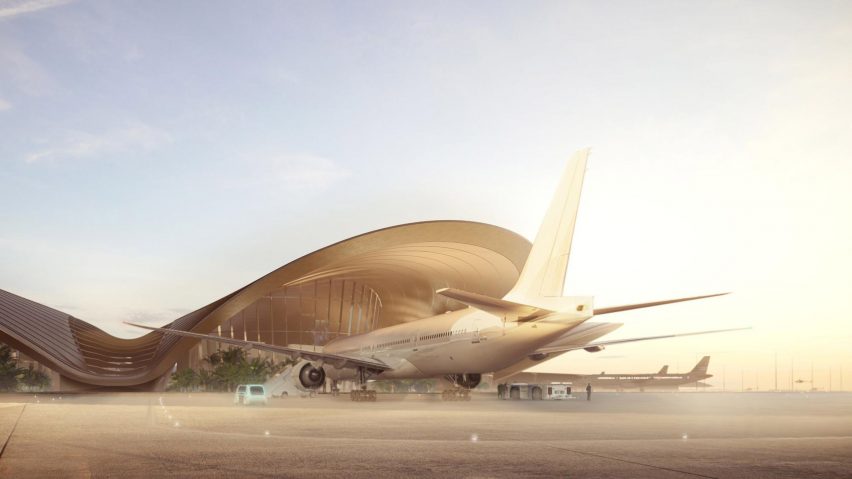
Construction begins on Foster + Partners' Red Sea International Airport in Saudi Arabia
Work has started on building a Foster + Partners-designed international airport on the west coast of Saudi Arabia, which was "inspired by the colours and textures of the desert landscape".
Named the Red Sea International Airport, the building was designed by Foster + Partners as part of The Red Sea Project tourist development.
Earlier this year construction began on the airport, which is being built around 15 kilometres inland from the coast of the Red Sea, with site levelling currently underway.

Set to complete next year, the airport has been designed to reach a capacity of one million passengers a year by 2030.
It will almost exclusively serve tourists visiting The Red Sea Project tourist development, which is being developed nearby and will include a ring-shaped hotel on stilts above the Red Sea and a resort built among the Saudi Arabian sand dunes designed by Foster + Partners.

The form of the airport was informed by the desert that surrounds it. Visuals show a series of five dune-like pods that are arranged radially around a central drop-off and pick-up space.
Each of these pods will contain a departure lounge that will have spas and restaurants. Between the pods, spaces filled with greenery will be created for the first stage of the arrivals process.
Each of the five pods can be operated independently as a "mini terminal", meaning that parts of the airport can be shut during periods of low demand to reduce energy usage.

"The Red Sea International Airport has been envisaged as a gateway to one of the most unique resorts in the world and an integral part of the visitor experience," said Gerard Evenden, head of studio at Foster + Partners, when the project was first unveiled in 2019.
"Inspired by the colours and textures of the desert landscape, the design seeks to create a calm and luxurious journey through the terminal and will become a transit hub for visitors coming in by both land and air."

Two wings extending from either side of the main terminal will contain the airport's ancillary spaces including hangers, logistics bags and baggage handling facilities.
According to the studio, this configuration will reduce the overall envelope and energy demand in comparison to standard stand-alone ancillary buildings.

The studio is aiming for the airport to achieve a LEED Platinum sustainability rating. It will be powered by 100 per cent renewable energy and constructed and operated "using a zero single-use plastic ethos".
The terminal's roof shells will extend from the building to shade both the landside and airside areas of the airport.
"The overall form of the terminal building has been designed to protect the internal environment from solar gains and therefore substantially reduce the overall energy demand for cooling in the building through self-shading," said the studio.
"Daylight has also been considered with most of the glazing facing north allowing for increased daylight penetration without compromising solar performance."
Along with the main terminal building, a runway and dedicated seaplane runway, as well as three helipads, are under construction at the site.
Described by its developers as the "world's most ambitious tourism development", the Red Sea Project will see a chain of 90 undeveloped islands off the west coast of Saudi Arabia be developed into a tourist resort.
Alongside Foster + Partners, Kengo Kuma and Associates and Dubai-based Killa Design are designing hotels as part of the project.
The Red Sea Project is one of several tourist sites being developed in Saudi Arabia. In the AlUla desert French architect Jean Nouvel has designed a subterranean hotel and architecture studio AW2 is creating a glamping resort made up of 47 luxury tents.
Foster + Partners is also designing an international airport for the Amaala resort, which is being developed around 250 kilometres north of the Red Sea Project.
The "mirage-inspired" terminal drew criticism from the Architects Climate Action Network, which led to the Foster + partners withdrawing from Architects Declare environmental group, stating that aviation needs "the most sustainable buildings".